Rustic Spaghetti alla Gricia Recipe: A Taste of Roman Magic
Crafting an authentic spaghetti alla gricia might seem daunting for novice cooks seeking Roman culinary adventure.
Pasta enthusiasts recognize this classic dish as a pure celebration of simple ingredients.
Pecorino romano cheese and guanciale dance together, creating a creamy sauce without adding cream.
Each bite tells a story of traditional Italian cooking techniques passed through generations.
Robust flavors emerge from just four fundamental components: pasta, cheese, pork, and black pepper.
Smart home chefs can master this delectable recipe with minimal effort and maximum satisfaction.
Let’s uncover the secrets behind this delightful Roman classic that will transport you straight to the cobblestone streets of italy.
FAQs
Guanciale is cured pork cheek with a rich, intense flavor. You can find it in specialty Italian markets, some gourmet grocery stores, or online meat retailers. If unavailable, pancetta can be a suitable substitute.
Pasta water contains starch that helps create a smooth, silky sauce. The reserved water helps bind the cheese and fat, creating a creamy texture without using additional cream.
Pecorino Romano is traditional, but if you can’t find it, you can use Parmigiano-Reggiano. However, Pecorino gives the dish its authentic Roman flavor and saltiness.
The guanciale is ready when it turns golden brown and crispy, with its fat fully rendered. It should look slightly translucent and have a nice crunch when you bite into it.
Spaghetti alla Gricia in Its Purest Form
What Brings Spaghetti alla Gricia to Life
Main Ingredients:Seasoning and Additions:Optional Liquid:Creating the Perfect Spaghetti alla Gricia
Step 1: Boil Pasta to Perfection
Fill a large pot with water and add a generous pinch of salt.
Let the water reach a rolling boil, then gently slide in the spaghetti.
Cook until the pasta reaches that magical al dente texture, following the package guidance.
Before draining, carefully scoop out a cup of the starchy cooking water – this liquid gold will be your secret weapon later.
Step 2: Transform Guanciale into Crispy Delights
Grab a spacious skillet and warm it over medium heat.
Scatter the diced guanciale across the pan, letting it sizzle and dance.
Watch as the pieces turn golden and crisp, releasing their rich, irresistible fat.
This should take about 5-7 minutes.
Once beautifully caramelized, remove the skillet from the heat.
Step 3: Marry Pasta with Guanciale
Drain the spaghetti and introduce it to the skillet of crispy guanciale.
Pour in a splash of the reserved pasta water.
Toss and twirl the pasta, ensuring every strand gets coated in the luxurious rendered fat.
Step 4: Shower with Cheese and Pepper
Generously rain down the grated Pecorino Romano over the pasta.
Crack fresh black pepper across the surface, creating a beautiful speckled landscape.
Gently toss everything together, adding more pasta water if needed to create a silky, clinging sauce.
Step 5: Plate and Celebrate
Serve the pasta immediately, topped with an extra sprinkle of Pecorino Romano and a final twist of black pepper.
Your Spaghetti alla Gricia is ready to be devoured!
Fine Details for Spaghetti alla Gricia Success
Keeping Spaghetti alla Gricia Meal-Ready
Flavors That Complement Spaghetti alla Gricia
Creative Spins on Spaghetti alla Gricia
Print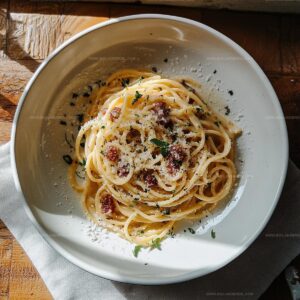
Spaghetti alla Gricia Recipe
- Total Time: 25 minutes
- Yield: 4 1x
Description
Spaghetti alla gricia brings Roman culinary magic to your plate, celebrating simplicity with guanciale, pecorino romano, and black pepper. Crispy pork and sharp cheese create a classic pasta experience you’ll savor with each delightful, authentic bite.
Ingredients
Main Protein:
- 150 grams (5.3 ounces) guanciale (or pancetta, diced)
Pasta and Cheese:
- 400 grams (14.1 ounces) spaghetti
- 100 grams (3.5 ounces) Pecorino Romano cheese (finely grated)
Seasonings:
- Salt (for pasta water)
- Freshly ground black pepper (to taste)
Instructions
- Prepare a generously salted water bath in a spacious pot, bringing it to a rolling boil. Immerse spaghetti and cook until perfectly tender, maintaining a firm bite. Carefully extract and preserve approximately one cup of starchy cooking liquid before straining.
- Simultaneously, transform diced guanciale in a capacious skillet over moderate heat. Allow the meat to sizzle and caramelize, rendering its rich fat until achieving a golden, crisp texture (roughly 5-7 minutes). Remove from thermal source once desired crispness emerges.
- Elegantly introduce the strained pasta into the skillet populated with rendered guanciale. Integrate the strands by gently rotating, utilizing a splash of reserved pasta water to facilitate seamless coating and prevent adherence.
- Lavishly dust the pasta with finely grated Pecorino Romano, accompanied by a robust scattering of freshly cracked black pepper. Vigorously toss the components, allowing the cheese to melt and create a silky, cohesive sauce. Incrementally incorporate additional pasta water if necessary to achieve optimal consistency.
- Present immediately, garnishing with an extra flourish of Pecorino Romano and a dramatic sprinkle of black pepper, ensuring maximum flavor and visual appeal.
Notes
- Opt for high-quality guanciale to elevate the dish’s authentic flavor and ensure a rich, delectable taste profile.
- Choose a good-quality Pecorino Romano with a sharp, salty character that melts smoothly into the pasta.
- Use starchy pasta water as a secret weapon to create a silky, emulsified sauce that perfectly coats every strand of spaghetti.
- Consider substituting pancetta if guanciale is unavailable, though the traditional flavor will be slightly different.
- Prep Time: 10 minutes
- Cook Time: 15 minutes
- Category: Dinner
- Method: Boiling
- Cuisine: Italian
Nutrition
- Serving Size: 4
- Calories: 645
- Sugar: 1g
- Sodium: 310mg
- Fat: 28g
- Saturated Fat: 10g
- Unsaturated Fat: 18g
- Trans Fat: 0g
- Carbohydrates: 80g
- Fiber: 3g
- Protein: 24g
- Cholesterol: 40mg

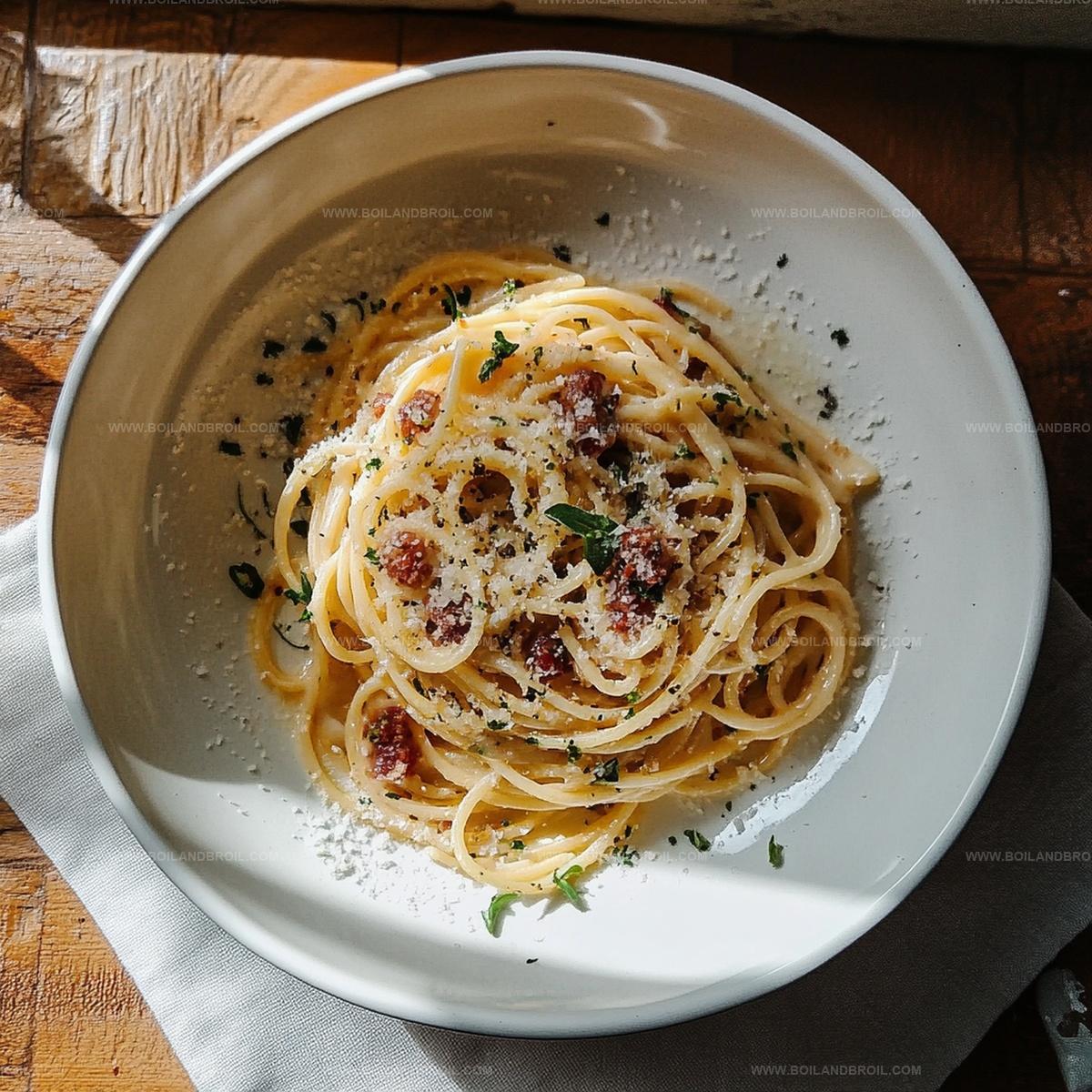
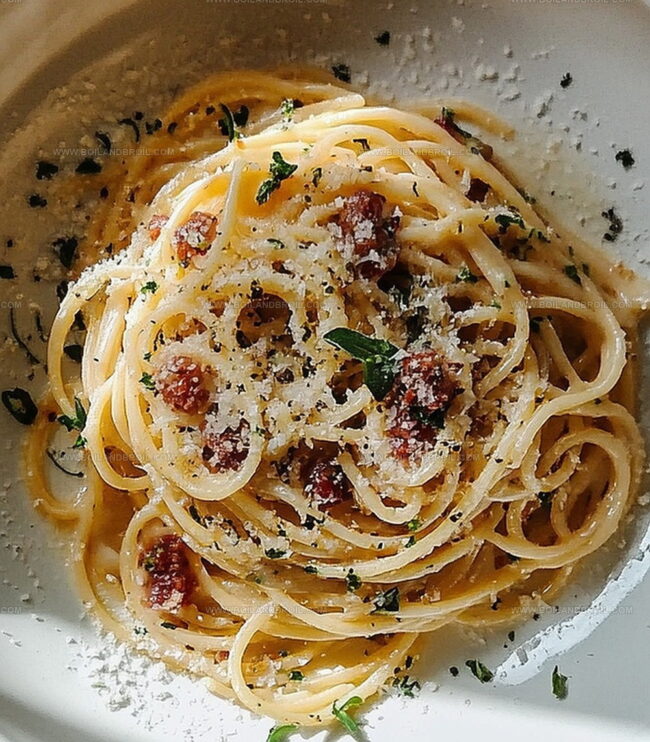
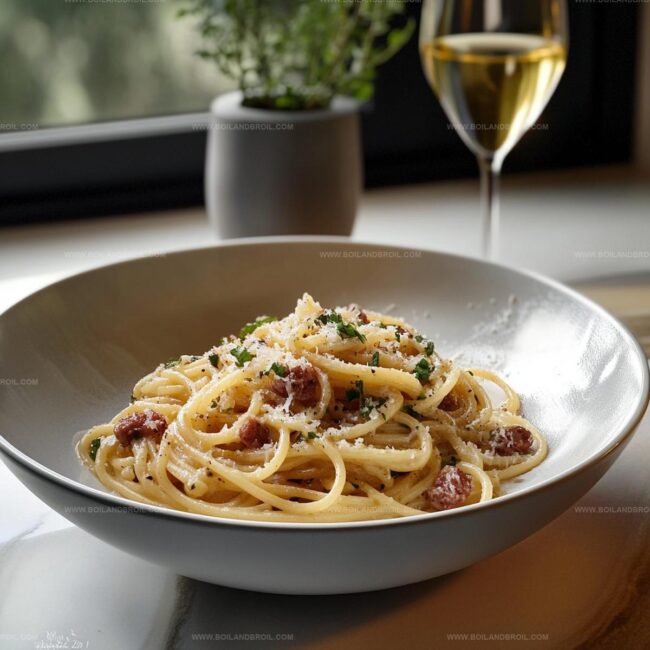
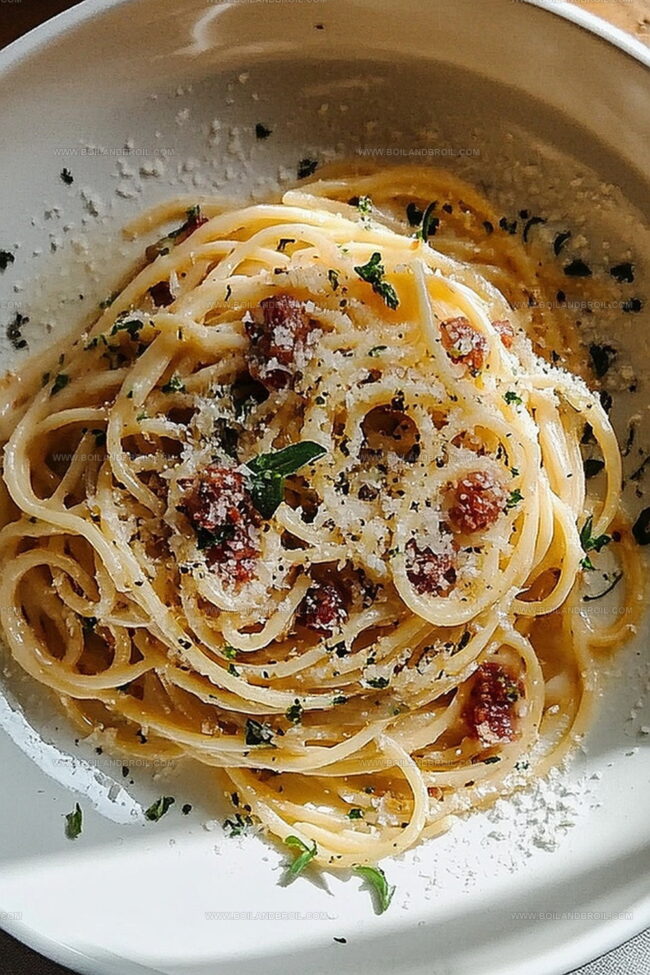
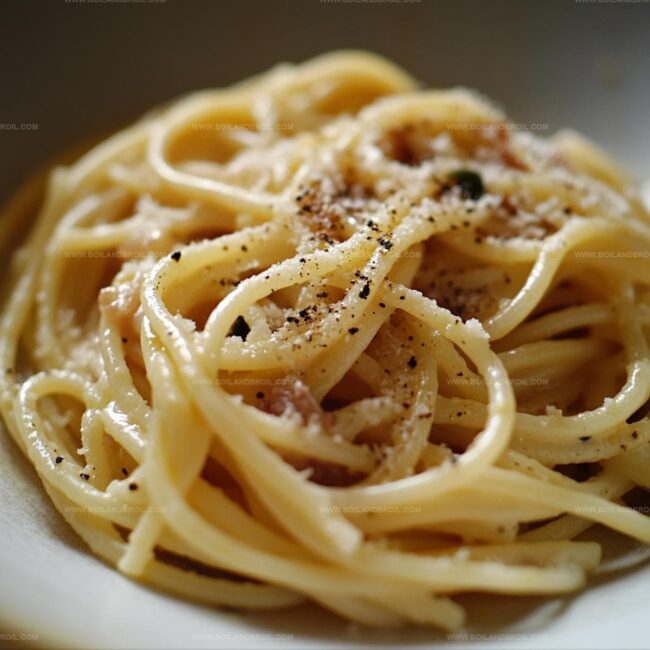
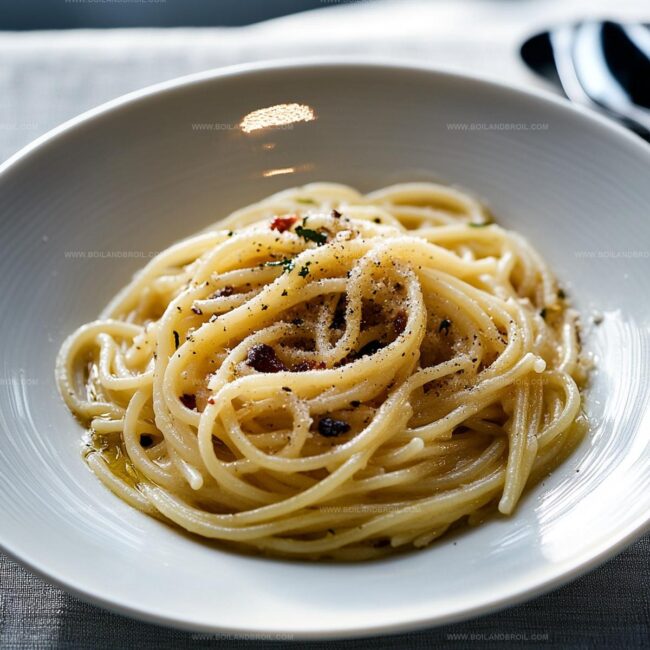
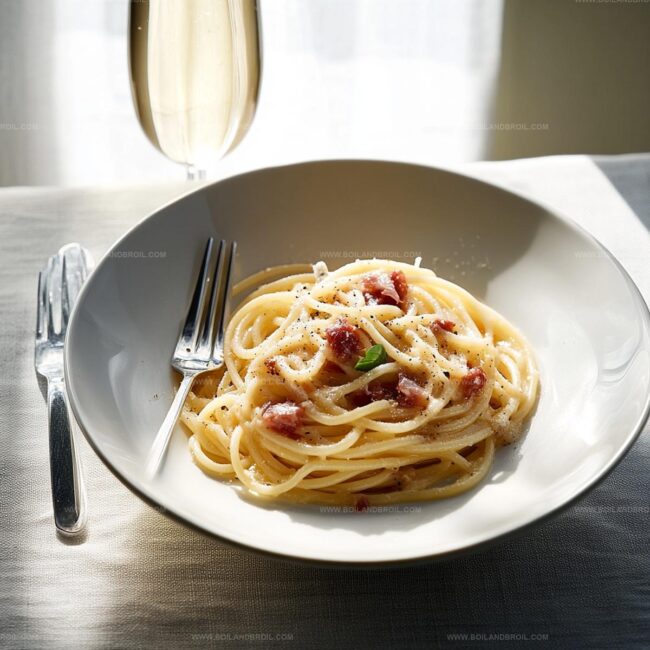
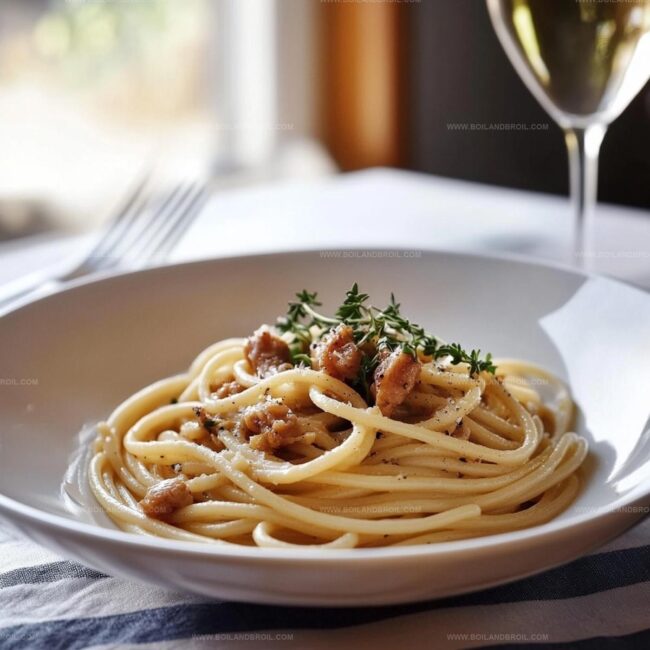
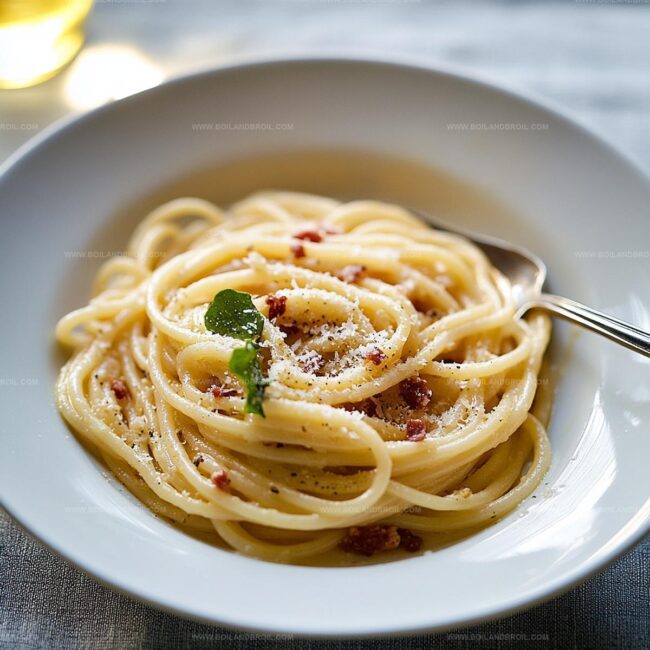
Jack Sullivan
Founder & Culinary Storyteller
Expertise
Single-recipe development with a narrative approach, Culinary storytelling and food history, Seasonal and regional ingredient utilization, Home cooking techniques adapted for modern kitchens
Education
New England Culinary Institute (Montpelier, VT)
Certificate in Culinary Arts
Focused on farm-to-table cooking, sustainable practices, and modern plating techniques.
Asheville-Buncombe Technical Community College
Associate Degree in Culinary Arts
Emphasized Southern Appalachian cuisine and local ingredient sourcing.
Jack grew up surrounded by smoky skillets and handwritten recipes in the mountains of North Carolina. His roots in Appalachian cooking shaped the way he sees food – as something that connects people, tells a story, and holds meaning.
With hands-on training and a background in sustainable, regional cooking, Jack started Boil And Broil to make meaningful meals more accessible. He’s all about one-dish recipes that are simple to follow but rich with flavor and history.